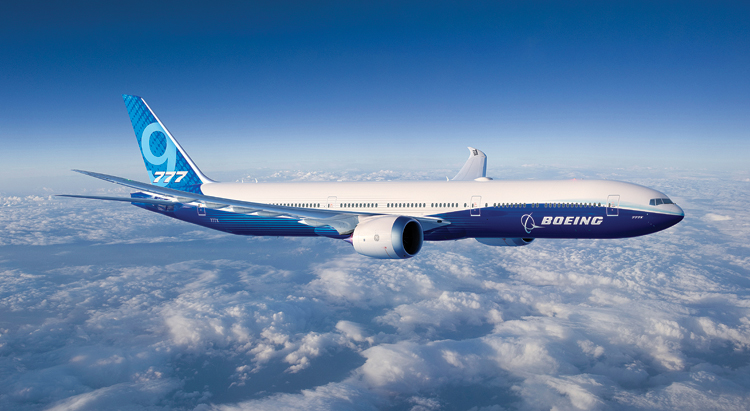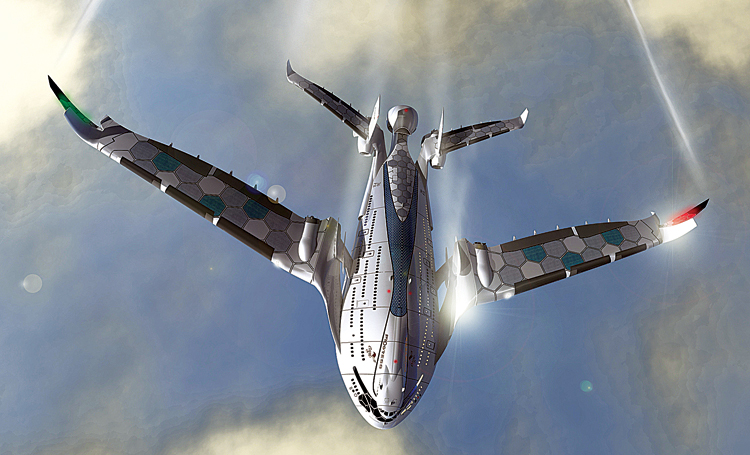Imminent Air Travel Transformations
With the ease of commute and rising travel demands, air transport as the mode of travelling is only gaining more popularity, accelerating the need to redesign and reinvent with some of the most innovatively conceptualised futuristic airliners

Change is the only constant and the swiftness with which technology changes these days only demands more creativity in the face of advancement. The aviation industry has gained immense popularity with the rapid rise in traveling, but that has not accelerated many major changes in the designing part of the airliners. The growth, however, still has been significant and is only sure to increase more.
According to the International Air Transport Association’s (IATA) trends analysis in air transport, passenger numbers could double to 8.2 billion in 2037. So as the aviation industry gears up for enhancement, it certainly is looking at advancement not only in the manner of sustainability and performance but also in the manner of redesigning the existing airliners.
While there still have been technical developments in commercial flying, when it comes to body design, the frame has more or less remained the same for years. Some of the reasons for its continuation could be the fact that globally the airport gates are built to handle this shape, the ease of maintenance since engines are mounted below the wings providing simple access for mechanics, along with the cautious approach of the industry toward adopting new technology after complete assurance.

However, with the gaining spotlight on the aviation industry, several concepts, and designs are in the pipeline that are sure to remove all structural similarities of the airliners and transform the way we travel. Some of the factors facilitating the redesign are:
ELECTRIC SHIFT
With a lot of focus on sustainability and reduction of fuels and emissions, the coming decades are likely to witness a major electric shift in the way air travel is perceived, more so in the short-haul flying. Smaller electric motors will make way for distributed propulsion, reduced noise levels as well as operational costs further ensuring electrical-powered air travel which is almost door-to-door like NASA’s X-57 prototype, Zunum’s hybrid-electric aircraft, Israel based Eviation’s all-electric light aircraft, Alice Commuter and many other concepts hoping to become a reality.
AUTOMATION
With the ever rising demands of air travel, the need for pilots is bound to witness a surge too. The recent times have already had instances of flight delays and cancellations owing to the shortage of pilots which is likely to continue. The idea certainly is not to let go off pilots, but the industry is coming up with the possibility of unmanned vehicles in the future like the Airbus’ air taxi, Volocopter’s optionally-piloted helicopter, etc. to let automation find a way into the industry’ although it will take quite a bit of time for people to trust that system.
DESIGN
As they say first impression is the last impression, the design which offers the first glimpse of an airliner is what attracts a customer foremost. A combination of abovementioned reasons certainly makes way for a whole new set of technologies and a lot of variations possible in the designing of an aircraft. A lot of upcoming airliners are conceptualising experimentation with the shape, the wings, the placement of the engine, the number of turbofans, the seating arrangement, the space in between, etc. to offer passengers an entirely new experience. For instance, Boeing’s Blended Wing Body Airlifter merge the plane’s body and wing, the large panoramic windows in the Kyoto cabin for Embraer’s Lineage 1000E aircraft and many more interesting designs.

CONVENIENCE
Convenience always finds priority among the customers. Especially with the large variety of airlines to choose from, the customers look for what suits them and provides them the maximum comfort in their desired amount. Convenience hence is a crucial factor that every aircraft manufacturer has in mind to become the preferred choice among frequent flyers. Airliners like the Airbus A220 and Embraer E2 with 2x2 seating are some examples targeting customer comfort.
SPEED
After Concorde made the buzz in the market years ago, there has not been an aircraft with the supersonic speed that has been a part of the industry. In a way, commercial aviation has moved backward in this area. However, certain start-ups like Boom, Aerion, Reaction Engines Limited, and others plan to come up with their supersonic and hypersonic aircraft in this fast-paced world. Airbus also won patent rights for their design of a new airplane called the Concorde 2, the first hypersonic airliner.
WITH A LOT OF FOCUS ON SUSTAINABILITY AND REDUCTION OF FUELS AND EMISSIONS, THE COMING DECADES ARE LIKELY TO WITNESS A MAJOR ELECTRIC SHIFT IN THE WAY AIR TRAVEL IS PERCEIVED, MORE SO IN THE SHORT-HAUL FLYING
Below are some of the airliners you must look out for as these are bound to change the way you air travel in the coming future:
- Flying-V: Taking the idea of futuristic design a notch up is the Flying-V which incorporates the passenger cabin, fuel tanks and cargo hold into the wings. With the aim to improve sustainability of air travel, the development of this V-shaped fuel-efficient airplane design received a push with the Dutch national carrier KLM Royal Dutch Airlines announcing to fund it. It’s claimed the plane will have 314 seats, a similar number of passengers as the Airbus A350-900. To accommodate the existing airport infrastructure the design also mirrors the A350’s 65-metre (213 feet) wingspan. While researchers hope to fly a scale model this September, the complete plane will only be ready to enter service between 2040 and 2050.
- Boeing 777X: Being billed by Boeing as the biggest and best of the whole product line, 777X with the passenger the capacity of 406, has a unique folding wing feature. The wing bends up at a right angle to let the widebody scrunch into tight docking spaces at airports. It is expected that Emirates will launch the jumbo into service in 2020. Lufthansa, Qatar, and Singapore Airlines are the first round of customers.
- Boom Supersonic: Denver-based startup company Boom has assured to produce the first supersonic jet since Concorde was retired 15 years ago. The demonstration flight is expected to be ready by the end of 2019 and the first delivery is aimed for 2025. 20 of the 55-seat airliners that are anticipated to fly just over twice the speed of sound i.e. Mach 2.2, will possibly be bought by Japan Airlines (an early investor in the company). The plane’s speed is expected to be restricted to subsonic or under 700 mph over land and let you fly from Tokyo to San Francisco in less than six hours. As of now, the company claims that the fares will be approximately as much as the business class prices.
- Airbus A220: Even while it seems as a rebranding of a new regional plane, the Bombardier CS300 series, Airbus A220 still promises to enhance comfortable traveling for the commuters. Available as the -100 version (having 110 fliers capacity) and the -300 (holding 130-160 fliers), the airliner upturns the expectations on short-haul routes with both the seat size (at least 18 inches) as well as the seating layout (2x3) standing out from the usual. Claustrophobia is likely to be tackled with its spacious overhead bins and two windows at each row. A220 also holds a promise of consuming less fuel and is expected to launch in 2022.
- Aurora’s D8: Looking like two cigars merged beside each other, Aurora’s D8 Double Bubble airliner is the double-wide fuselage that introduces a new, fuel-saving propulsion concept which the NASA researchers call Boundary Layer Ingestion, or BLI. Being developed in concert with MIT and Pratt & Whitney, the engines of the D8 move away from the “clean” airflow conditions right under the wings to the top rear of the double-wide fuselage. The challenge is to see if the smaller, lighter turbofans can operate in the unsteady air flows at the back of the plane.
- CityAirbus: The multi-passenger autonomously piloted electric vertical take-off and landing (eVTOL) vehicle designed for urban air mobility (UAM) will soon be coming along. The CityAirbus was demonstrated for the first time to the public at Ingolstadt, Germany in March 2019 and a proof of concept ready for commercial operation is scheduled for 2020. Early this year, Airbus Helicopter completed ground testing for the UAM technology demonstrator which is a part of an Airbus strategy. The vehicle explores the potential of UAM in the fields of connectivity, artificial intelligence, autonomous systems, and electric propulsion.
- Alice Commuter: During the 2017 Paris Air Show, Alice Commuter, the all-electric light aircraft of the Israeli startup company, Eviation was revealed. Designed with a total of 6,000 pounds of lithium-ion batteries for power, distributed propulsion with the main pusher propeller at the tail and two at the wingtips, Alice Commuter can carry up to nine passengers for a range of 600 miles.
- Aether airship: Once a significant part of commercial aviation, airships had gradually faded off in the mid-20th century. However, this scene might change once the conceptualised Aether airship becomes a reality. Designed by Mac Byers, the Aether airship has a long, shark-like appearance and is more like a cruise ship than a normal airliner. With large windows, passengers would also enjoy a large variety of dining options and comfortable rooms to stay in.
- SpaceLiner: Taking the idea of high-speed travel, the German Aerospace Center (GAC) is developing a spaceplane under the name of SpaceLiner which brings together the best characteristics of an airplane and a rocket. This is a two-stage concept like the US space shuttle where the spaceplane goes up to high orbit on a cryogenic rocket booster which then drops away. The SpaceLiner is expected to let you from Australia to Europe in less than 90 minutes as it will accelerate to Mach 25 at extremely high altitudes and then land like any normal airplane when the trip ends. Using liquid hydrogen and liquid oxygen as rocket propellant, the SpaceLiner is environmentally friendly and is expected to be in operation by 2050.
- AWWA-QG Progress Eagle: Presumable the most complex concept airplane, the AWWA-QG Progress Eagle is a reasonable proposal for a large, environmentally friendly passenger airplane. The huge triple-deck design can accommodate 800 passengers and has folding wings to fit into the present airports’ infrastructure. Designed by Oscar Vinals, the airliner uses six hydrogen-powered engines for power that also provide electricity during the flight. There are solar panels in the wings that facilitate most of the electricity. A CO2 cleaner would also be installed to clean the air through which it passes. It is expected to enter service in 2030.





